Three scientists won the Nobel Prize in chemistry: they created a rechargeable world.

On the evening of October 9th, Beijing time, the Royal Swedish Academy of Sciences announced that the 2019 Nobel Prize in Chemistry was awarded to Goodenough, a professor at the University of Texas at Austin, Whittingham, a professor at the State University of New York at Binghamton, and Akio Yoshino, a Japanese chemist, in recognition of their contributions in the field of lithium-ion batteries.
The three will share the prize of 9 million Swedish kronor (about 6.47 million yuan) equally. The Nobel Committee commented that "they created a rechargeable world".
It is worth mentioning that Goodenough, born in 1922, is 97 years old this year. This award has also set a new age record for the Nobel Prize.
Lithium batteries have completely changed life.
Li-ion battery research, which has been "running with you" for many years, finally won the Nobel Prize in chemistry this year.
After this year’s awards were awarded, the academic circles have said that the three scholars won the awards as "widely expected". Jiang Xuefeng, a professor at the School of Chemistry and Molecular Engineering of East China Normal University, commented that the three Nobel Prize winners played an important role in the basic model construction and industrial promotion of lithium-ion batteries.
The Nobel Committee commented that lithium-ion batteries have completely changed our lives since they first entered the market in 1991. Today, mobile phones, cameras and even electric cars, as well as pacemakers, etc., the most important energy source is lithium-ion batteries.
In addition, lithium-ion batteries are widely used to store other renewable energy sources, such as solar energy and wind energy, thus effectively reducing greenhouse gas emissions.
Lithium-ion battery is a kind of secondary battery, also known as rechargeable battery. Inside the battery, lithium ions (charged atoms) move along the path between two electrodes, thus generating current.
"Lithium atom has a unique property, its outer layer has only one electron, which is very easy to lose. Lithium batteries use the property that lithium atoms are easy to lose electrons, so that electrons can be transmitted on external wires and power equipment that needs electricity. " Jiang Xuefeng interprets the principle of lithium batteries.
Jiang Xuefeng introduced that if the battery wants to be recycled, it needs to turn the gain and loss of electrons into a reversible process, which requires selecting the anode and cathode materials of the battery. "It can be seen that three scientists have been using different materials to solve such problems in the development of lithium batteries."
The design foundation of today’s lithium-ion batteries was laid during the oil crisis in the 1970s. At that time, Whittingham, who worked for Exxon, an energy company, drafted the initial design scheme of lithium battery, using titanium sulfide as cathode material and metallic lithium as anode material, and made the first new lithium battery.
Ramster Romm, a member of the Nobel Prize Committee and a professor of chemistry at Linnaeus University in Sweden, introduced at the press conference that the potential of lithium metal batteries in Whittingham reached 2V. "The alkaline battery we use today is only 1.5V, so in terms of potential, this battery is quite good." Ramster Roma said.
In 1980, another Nobel Prize winner, Goodenough, discovered that lithium cobaltate could be used as cathode material for lithium ion batteries. The potential of this material is higher, reaching 4V— — As stated in the award speech, "the potential of the lithium battery has doubled".
Up to now, lithium cobaltate is still the most widely used cathode material for lithium ion batteries. Moreover, Goodenough also developed Ferrous lithium phosphate and other new lithium battery materials, and he was also honored as "the father of lithium batteries".
Solve the security problem and officially enter the business.
Lithium is a very active element. In order to avoid reacting with air, pure lithium is usually kept in oil. This also means that there will be safety hazards when lithium metal is used in batteries; In Whittingham’s early experiments, battery short-circuit explosion is common. This is one of the reasons why the above lithium battery can’t get out of the laboratory.
Scientists have been looking for ways to tame lithium.
In the 1980s, Japan’s consumer electronics industry was developed, so there was an urgent need for a lightweight and rechargeable battery to power camcorders, wireless phones and mobile computers.
Akira Yoshino, a chemical engineer working for Asahi Kasei Company, tried to find a safe and commercially available lithium-ion battery from Goodenough’s research. According to Goodenough’s theoretical model, he used lithium cobaltate as cathode and tried to use various carbon-based materials as anode. Yoshino Akira was very careful when testing the safety of the battery, and even put the testing work in a room dedicated to explosives inspection.
In 1985, Akira Yoshino replaced the reactive lithium in the anode with petroleum coke, a carbon-based material, thus completely eliminating metallic lithium and completing the world’s first commercialized lithium-containing alkaline lithium-ion battery.
Solved the safety problem, which means the arrival of the commercial era of lithium batteries. This new type of safe lithium-ion battery is favored by Sony. In 1991, Sony and Asahi Kasei released the world’s first commercial lithium-ion battery, which opened the "lithium-ion battery revolution" of consumer electronics products.
The Nobel Committee commented that this "lightweight and durable battery can be recharged hundreds of times before its performance declines". (Nanfang Daily reporter in Beijing Wang Shizhen Planning: Zhang Zhichao)